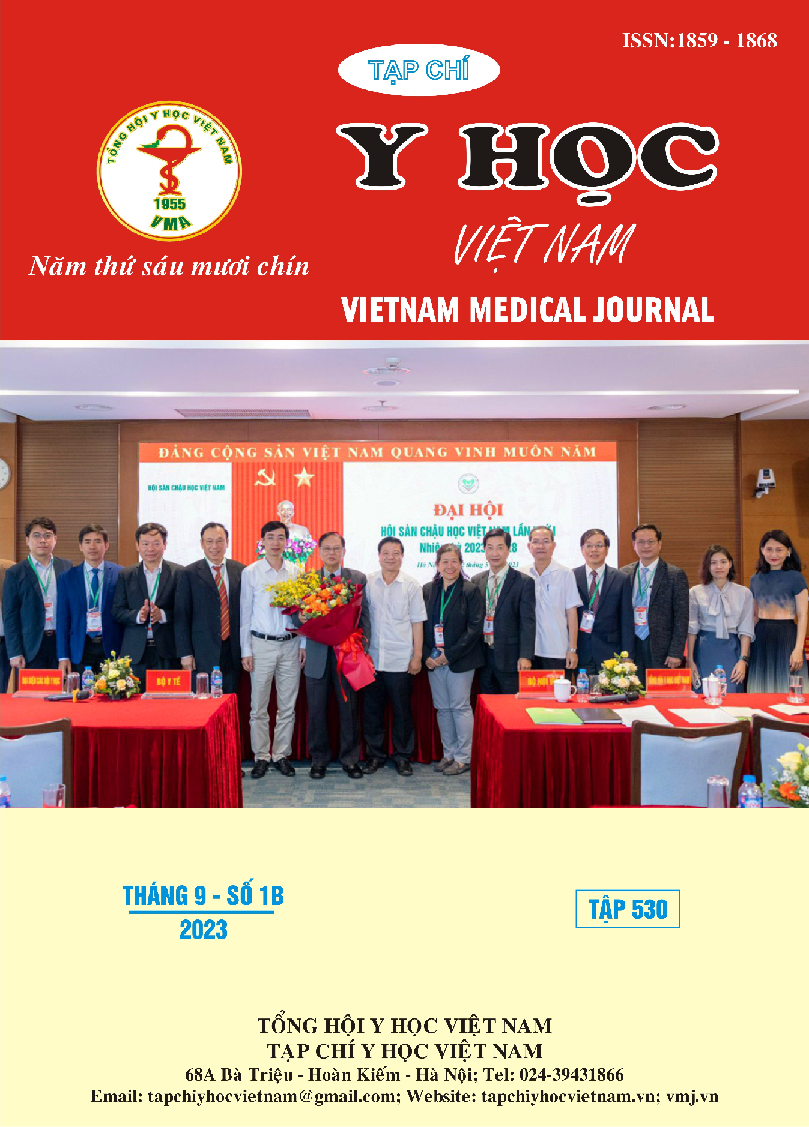MINI PERCUTANEOUS NEPHROLITHOTOMY IN THE TREATMENT OF KIDNEY STONES: INITIAL RESULTS AT THE MEDICAL CENTER CAM KHE-PHU THO
Main Article Content
Abstract
Objectives: The aim of this research is to evaluate the efficacy and safety of mini percutaneous nephrolithotomy in the treatment of kidney stones. Patients and methods: A retrospective combine prospective-descrivetive study of 92 patients suffering from kidney stones treated by mini-PCNL at Medical Center Cam Khe-Phu Tho from 1/2022 to 6/2023. The technique is performed under ultrasound, using a 16 Fr nephroscope of Karl-Storz. Holmium laser is used to disintegrate the stones. Evaluate the stones free rate and complications postoperatively. Results: 92 patient 60 males (65,2%) and 32 females (34,8%) with the mean age of 52±11,76 years (range from 19 to 70 year old). 73,9% have one stones, 26,1% have more two stones. The grade of hydronephrosis on preoperative MSCT: No hydonephrosis and grade I (21,7% and 42,7%), grade II (28,3 %), and grade III (7,6 %). Average length stone size 25,7±5,9 mm, average width stone size 16,3±2,5 mm. Operative time 71,86±15,09minutes (45 - 80). Postoperative stone free rate 79,3%, stone free rate at 1 month postoperative follow-up 90,2 %. 80 patient follow-up 20 ± 6 tháng. There are 2 patient have piece stone fall ureter need retrograde ureteral lithotripsy. 1 patient have stenosis ureter need cut and retrograde ureteral stenting with double J. No case required blood transfusion, renal atrophy, kidney failure, sepsis. Time postoperative hospital stay 7,67±3,21 days (4-10). Conclusions: Mini-PCNL was successfully performed at Cam Khe-Phu Tho Medical Center with encouraged initial outcomes. High stone free rate, shorter hospital stay, no major complication. Further research should be conducted in order to full-fil access the effectiveness and safety of mini-PCNL in patients with larger kidney stone.
Article Details
Keywords
Mini percutaneous nephrolithotomy, kidney stone, minimal invasive procedure.
References
2. Wang M, Bukavina L, Mishra K, Mahran A, Ponsky L, Gnessin E. Kidney volume loss following percutaneous nephrolithotomy utilizing 3D planimetry. Urolithiasis. 2020;48(3):257-261.
3. Vũ Nguyễn Khải Ca. Nghiên cứu ứng dụng phương pháp tán sỏi qua da trong điều trị sỏi thận tại Bệnh viện Việt Đức.2009; Luận án tiến sỹ y học.
4. Hennessey D.B., Kinnear N.K., Troy A. et al. (2017). Mini PCNL for renal calculi: does size matter?. BJU Int, 119 Suppl 5, 39–46
5. Đỗ Trường Thành, Đỗ Ngọc sơn, Nguyễn Huy Hoàng và cộng sự. Đánh giá hiệu quả phương pháp tán sỏi thận qua da đường hầm nhỏ dưới hướng dẫn của siêu âm, ở tư thế nằm nghiêng tại Bệnh viện Hữu nghị Việt Đức. Tạp chí y học Việt Nam tháng 8 số đặc biệt tập 481, hội nghị khoa học thận tiết niệu lần thứ XIII; 2019, 300-306.
6. Hoàng Long, Chu Văn Lâm, Ngô Đậu Quyền, Trần Quốc Hòa. Hiệu quả tán sỏi thận qua da đường hầm nhỏ ở tư thế nghiêng và không dẫn lưu thận. Tạp chí Y học Việt Nam, Tập 481-Tháng 8-Số Đặc Biệt.2019;180–193.
7. Lương Hồng Thanh (2018). Đánh giá kết quả tán sỏi thận qua da bằng phương pháp đường hầm nhỏ - tư thế nằm nghiêng tại bệnh viện Hữu Nghị Việt Đức. Luận văn tốt nghiệp chuyên khoa II, trường đại học Y Hà Nội.
8. Nguyễn Vũ Khải Ca, Hoàng Long, Chu Văn Lâm, Trần Chí Thanh, Nguyễn Thị Hương, Nguyễn Ngọc Thái, Vũ Văn Hà, Nguyễn Đức Minh, Hồ Đức Thắng. Tán sỏi thận qua da bằng đường hầm nhỏ dưới hướng dẫn siêu âm. Y học TP. HCM, tập 19 số 4*2015, tr.277-281
9. Nguyễn Phúc Cẩm Hoàng, Lê Trọng Khôi, Nguyễn Tuấn Vinh, Trần Vĩnh Hưng (2016). Đánh giá kết quả và độ an toàn của phẫu thuật lấy sỏi thận qua da đường hầm nhỏ trong điều trị sỏi thận đơn giản .Y học Việt Nam tập 445, tr225- 228
10. Özgör F., Küçüktopcu O., Şimşek A. et al. (2015). Percutaneous nephrolithotomy for isolated calyceal stones: How important is the stone location?. Turk J Urol, 41(4), 171–176


